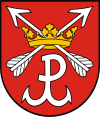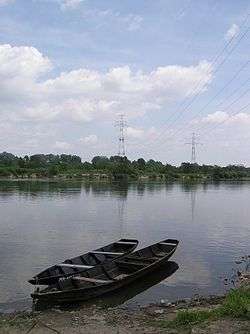Łomianki
Łomianki [wɔˈmʲaŋkʲi] is a town in Warsaw West County, Masovian Voivodeship, Poland.[1] It had a population of 16,374 in 2008, and 24,328 in 2016.[2]
Łomianki | |
|---|---|
.jpg) Main street in Łomianki | |
 Flag  Coat of arms | |
 Łomianki | |
| Coordinates: 52°20′N 20°53′E | |
| Country | Poland |
| Voivodeship | Masovian |
| County | Warsaw West |
| Gmina | Łomianki |
| Town rights | 1.1.1989 |
| Government | |
| • Mayor | Małgorzata Żebrowska-Piotrak |
| Area | |
| • Total | 8.4 km2 (3.2 sq mi) |
| Elevation | 73 m (240 ft) |
| Population (2008) | |
| • Total | 16,374 |
| • Density | 1,900/km2 (5,000/sq mi) |
| Time zone | UTC+1 (CET) |
| • Summer (DST) | UTC+2 (CEST) |
| Postal code | 05-092 |
| Area code(s) | +48 22 |
| Car plates | WZ |
| Website | http://www.lomianki.pl/ |
Attractions
Because the town is located between Kampinos National Park and Vistula river, and just a short distance from the outskirts of Warsaw, it is regarded as a desirable place to live for people who want to combine an outdoor lifestyle while still commuting each day to Warsaw. Kampinos National Park has hundreds of kilometers of cycling trails and the largest inland sand dunes in Europe. Elk and wild boar are often seen there. Lomianki is characterised by big residential houses, particularly around Ulica Zachodnia, and many active community groups. Many expats live in Lomianki, mostly because it is equidistant between the city's two international airports, Chopin and Modlin.
Of interest in Łomianki are the Jazz Cafe where live music from all over Poland and beyond is a regular feature, Manufaktura Czekolady which is the only place in Poland where chocolate is made from bean to bar, and the Lemon Tree Pub where most community events are hosted. There are two Italian restaurants, both run by Italians, as well as a gourmet burger bar, a sushi restaurant.
Twin towns and sister cities


Gallery
 E77 road in Łomianki
E77 road in Łomianki New settlement in town
New settlement in town Parish church of Margaret the Virgin
Parish church of Margaret the Virgin Vistula powerline crossing
Vistula powerline crossing
References
- "Central Statistical Office (GUS) - TERYT (National Register of Territorial Land Apportionment Journal)" (in Polish). 2008-06-01.
- "Central Statistical Office (GUS) - Ludność. Stan i struktura w przekroju terytorialnym (Stan w dniu 31 XII 2008 r.)" (PDF) (in Polish). 2009-07-19.
External links
| Wikimedia Commons has media related to Łomianki. |
- Official website (in Polish)
- Jewish Community in Łomianki on Virtual Shtetl